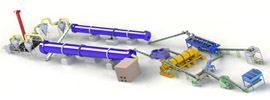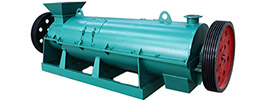The completion of organic fertilizer fermentation requires a comprehensive evaluation across multiple dimensions. Below are the detailed criteria and methods:
I. Core Evaluation Criteria
1. Temperature Dynamics
- Composting:
- Thermophilic Phase: Initial temperature rise to 50–65℃ (maintained for 5–6 days for sterilization).
- Cooling Phase: Temperature gradually drops to ambient levels or slightly elevated (typically <40℃), indicating progression to the maturation phase.
- Biogas Fermentation:
- Stable gas production with ignitable output, pH stabilization between 6.5–7.5, and absence of acidification (e.g., non-yellowing fermentation broth) indicate balanced activity between acidogenic and methanogenic bacteria.
2. Sensory Characteristics
- Color:
- Raw materials transition from bright hues (e.g., golden straw) to dark brown or black, indicating thorough organic matter decomposition.
- Odor:
- Initial strong odors (e.g., ammonia, hydrogen sulfide) diminish, replaced by earthy or mild alcoholic notes, with no offensive smells.
- Texture:
- Material transforms from loose to soft and friable, with no coarse particles or agglomerates, achieving a fine, homogeneous consistency.
3. Chemical Parameters
- C/N Ratio:
- Composting: Maturation occurs when the initial C/N ratio (25–35:1) decreases to 15–20:1, or the water-soluble organic carbon/organic nitrogen ratio reaches 5–6.
- Biogas Fermentation: Optimal C/N ratio is 20–30:1.
- Organic Matter Content:
- Volatile solids content decreases by 15–30%, indicating stabilized organic matter.
- Nitrogen Forms:
- Ammonia nitrogen decreases, nitrate nitrogen increases, and total nitrogen content stabilizes.
4. Biological Indicators
- Seed Germination Test:
- Organic fertilizer leachate, compared to control water, achieves ≥50% seed germination rate with normal seedling growth, indicating absence of phytotoxicity.
- Microbial Activity:
- Reduced CO₂ production and oxygen consumption rates, dormant microorganisms, and decreased enzyme activity.
5. Laboratory Analysis
- pH Value:
- Composting: Final pH stabilizes between 5.5–8.5.
- Biogas Fermentation: pH stabilizes between 6.5–7.5.
- Hygiene Standards:
- E. coli Count: ≤10–100 CFU/g of organic fertilizer.
- Ascaris Egg Mortality: ≥95%.
- Heavy Metal Content: Complies with national standards (e.g., GB 38400-2019).
6. Additional Criteria for Specific Fermentation Types
- Biogas Fermentation:
- Stable gas production with ignitable output and stable pH (no acidification).
- Liquid Fermentation:
- Rapid dissolution of material in water with no impurity precipitation.
II. Evaluation Workflow
- Initial Observation:
- Temperature drops to ambient levels, color darkens, odor becomes earthy, and texture softens.
- Simple Tests:
- Seed Germination Test: ≥50% germination rate in leachate vs. control.
- Dissolution Test (liquid fermentation): Rapid dissolution with no sediment.
- Laboratory Testing (if required):
- pH, C/N ratio, heavy metals, E. coli count, and Ascaris egg mortality analysis.
III. Fermentation Duration Guidelines
- Composting:
- Thermophilic Phase: 1–2 weeks (50–65℃).
- Maturation Phase: Several weeks to months (depending on raw materials and conditions).
- Biogas Fermentation:
- Start-Up Phase: Several days to two weeks (until stable gas production).
IV. Key Precautions
- Turning and Aeration: Regular turning during the thermophilic phase maintains aeration and prevents localized anaerobic conditions.
- Moisture Control: Maintain 50–60% moisture; excessive moisture promotes anaerobic bacteria, while insufficient dryness delays fermentation.
- Feedstock Ratio: Adjust C/N ratio to appropriate ranges (25–35:1 for composting, 20–30:1 for biogas).
By integrating these criteria, organic fertilizer fermentation completion can be accurately determined, ensuring safety and efficacy for agricultural use.
 Send us a Email
Send us a Email Wulong Industrial Cluster
Wulong Industrial Cluster Have any question?
Have any question?



















